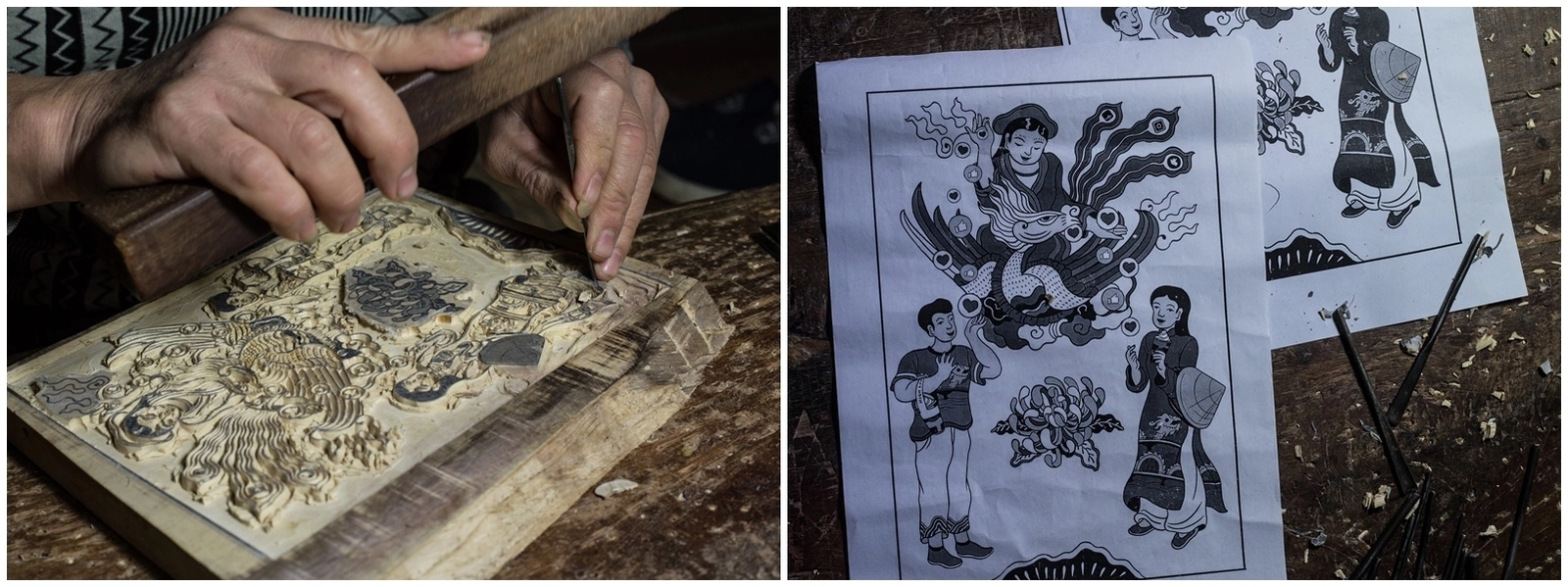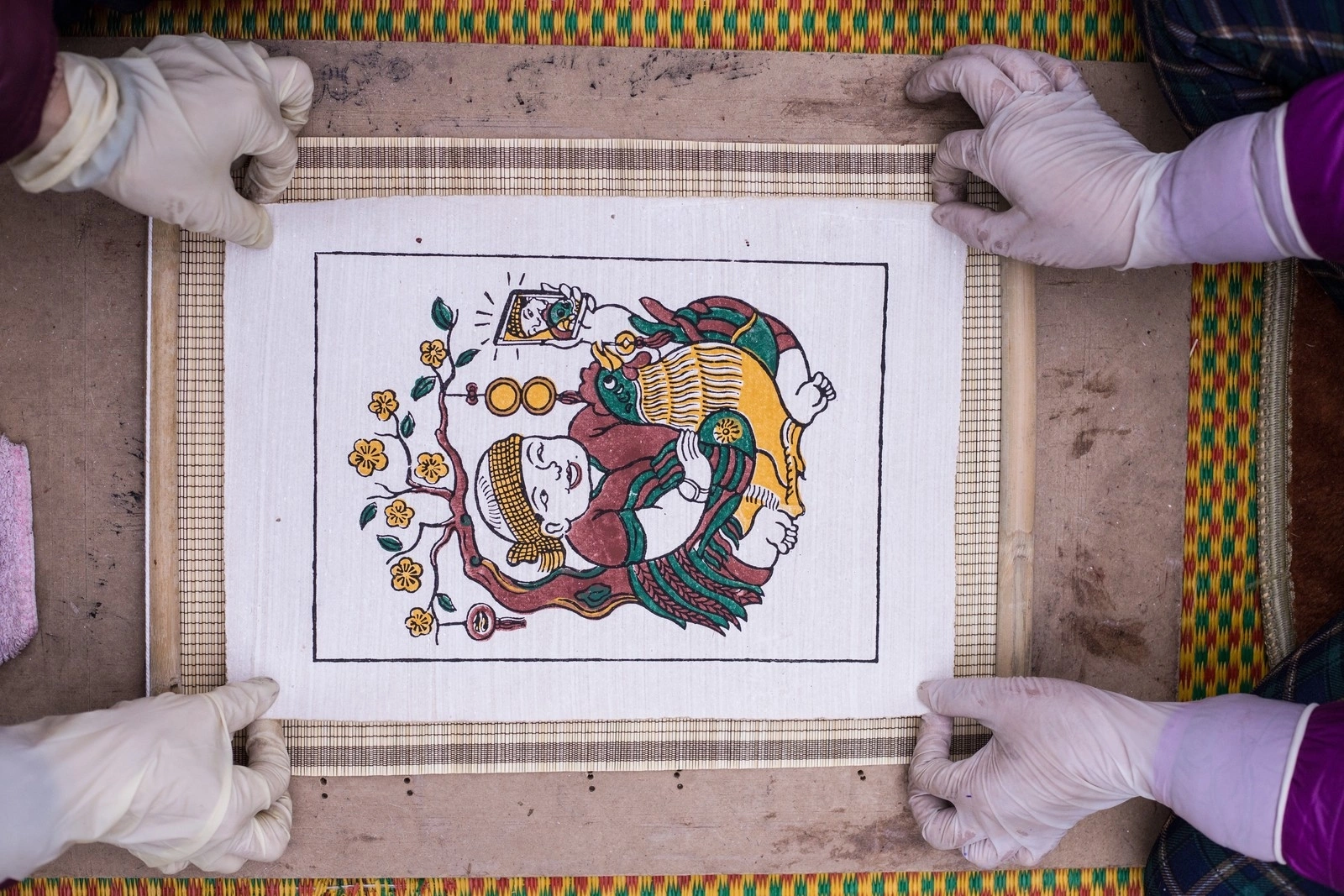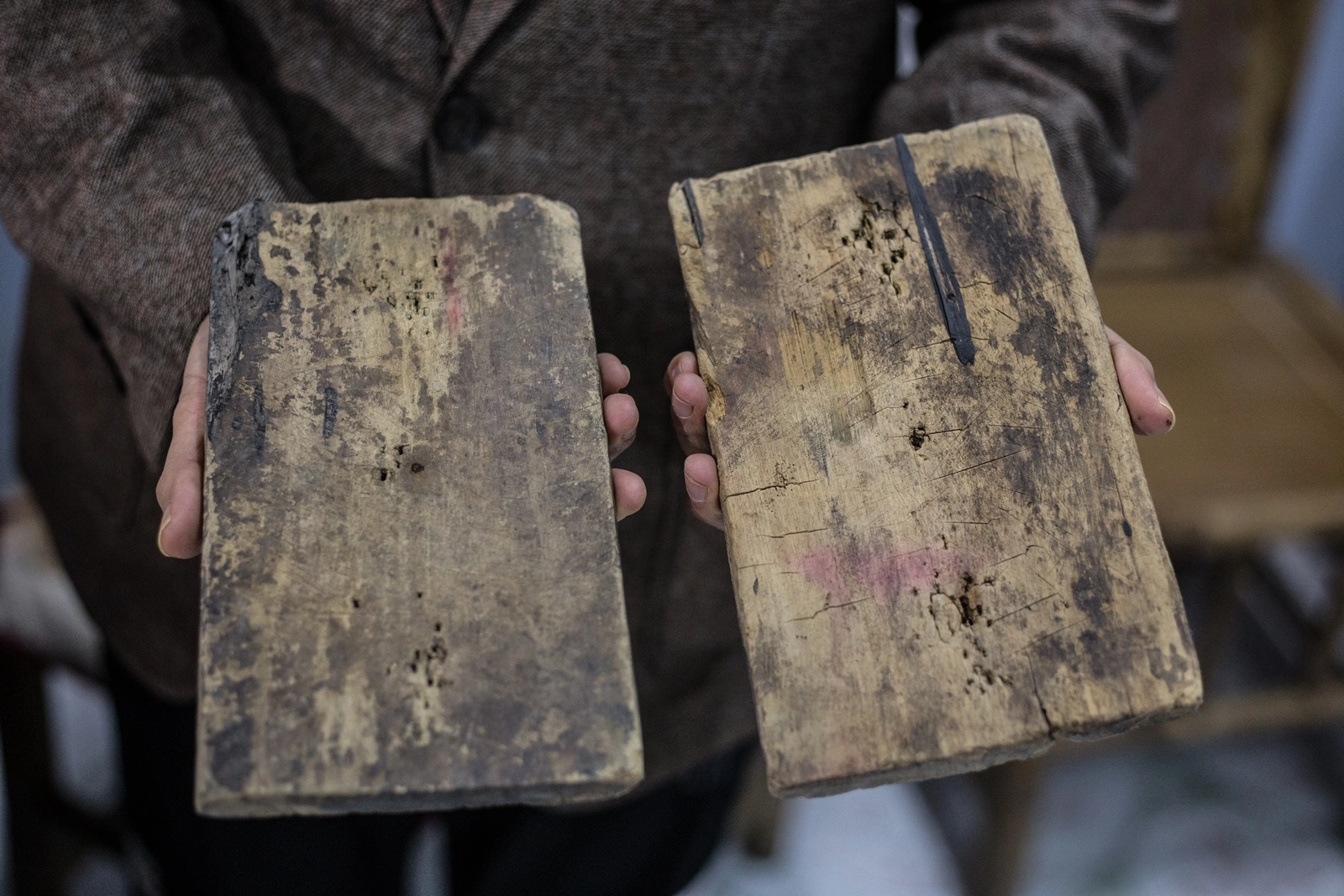The Vietnamese village that is home to this art lost almost all its treasures in the form of paintings and woodblocks when the French torched many of its homes, and in an ironic twist of fate, now sells paper offerings to burn.
Meanwhile, a handful of people trying to preserve and promote this art face new problems.
To illustrate this, artist Nguyen Huu Qua spreads out two versions of a popular Vietnamese motif – “The Rat’s Wedding.”
One is a painting made by him and the other is one bought from a shop selling souvenirs in Saigon.
Even to a layperson, the differences between the two are obvious.
The mass produced one is printed, not painted, on thin paper with pale and blurred brush strokes, and several details are left without colors.
And those who know Chinese characters will see more inaccuracies in the painting from the gift shop.

The “Rat’s wedding” painting by artisans in Dong Ho Village and the one sold at a giftshop when put under the same condition of light and temperature.
“A Dong Ho painting does not just have the picture. It also has Chinese letters to pass on a message. In the 'Rat’s Wedding,' the (original) artist wanted to highlight domination of the feudal class, so they made the cat bigger and scarier and somehow, it ended up looking like a tiger. So, they put the Chinese word “cat” on the head of this cat, so that people will not mistakenly assume it is a tiger,” Qua explained.
The Chinese word “cat” written on the painting from the giftshop, meanwhile, is not accurate. The word “groom” next to the rat that rides the horse lacks some strokes.
“The problem here is not real or fake painting but that the people who make Dong Ho painting copies do not put their soul into the work. They only focus on profit and have no real technique or knowledge of paintings,” Qua said.
For him, the painting at the giftshop “meets no standard at all.”
Yes, this “counterfeit” is what sells for several hundred thousand dongs (dozens of U.S. dollars). What Qua makes costs one-third of the copy, but neighbors and wholesale buyers think it is too costly.
The village
The Dong Ho painting originated in an eponymous craft village on the banks of the Duong River in Bac Ninh Province, about 35 km (21 miles) from Hanoi.
The traditional themes of Dong Ho paintings are good luck signs, historical figures, folk allegories, popular stories, and social commentaries.
Artist Le Huy Hoan lets his memories flash back to a winter day eight decades ago: the 16th day of the last lunar month and Dong Ho Village is open for traders from nearby areas.
The sun is yet to come up, but boats have already crowded the pier along the Duong River. In the boats are various goodies including fish sauce, silk, mats, tea and tobacco. Villagers were okay with barter trade then, and offered their paintings for payment in kind.
Hoan and his siblings are used to waking up early to help their parents with daily jobs, and today is no exception. Together, the family carry their paintings to the village’s communal house and Hoan hangs big paintings up and lays smaller ones on a mat to make it easy for customers to take a look.
Every Tet, or Lunar New Year, Hoan’s family is able to sell tens of thousands of paintings, and his parents start making them months before the festival to meet the high demand.

In those days, it was said that a newlywed woman could forget to buy flowers or firecrackers when she returns home from the Tet market, but if she forgot to bring home several Dong Ho paintings to decorate the house for the New Year, her parents in law would not be very happy.
A pair of new Dong Ho paintings in the house symbolized a wish for a peaceful and prosperous new year.
“A Dong Ho painting is simple, symbolic, broad-minded and humorous. Viewers may not see the message at first glance but if they look more carefully, they will find that the paintings are very human,” said Nguyen Dang Che, the oldest artist in Dong Ho, as he turned over several Dong Ho paintings.

Che stopped at each painting to explain the message, like how people those days criticized extra-marital affairs in the “Danh ghen” (scene of jealousy), and corruption in the “Rat’s wedding.” The “Baby boy holds chicken” and “Baby girl holds duck” paintings, meanwhile, expressed desire for glory and prosperity.
The village artists created paintings completely from natural materials such as scallop shells for diep paper and the barks of do (rhamnoneuron balansae), a highly cellulose tree, for do paper. They also used natural ingredients for colors.
The last stage of making a Dong Ho painting was printing. Paint was applied to the woodblock and pressed on a sheet of paper, like a stamp. The process was repeated with different colors until the artist was satisfied with the painting.
The original Dong Ho paintings did not have garish colors. They were warm and easy to the eye, all made from all natural materials: black from the ash of burned bamboo leaves, yellow from flowers of the Japanese pagoda tree, red from sappanwood, and green from the bark of cajuput trees.
Each painting usually had four to five colors, which meant the painters had to prepare that many woodblocks. The yellow was printed first and the paper let to dry before the green and the red patterns followed. Black was always the last color to be stamped.
The process may sound simple, but it is a painstaking one, from making the colors to carefully printing it so that the final painting is smooth and has clear strokes.
At first, villagers in Bac Ninh Province only bought Dong Ho paintings during Tet. That’s why they were also called “Tet paintings.” And as the good reputation spread, people from all over northern Vietnam came to Dong Ho to purchase the folk paintings.
Artists in Dong Ho could make a living from the paintings even as they pursued the art for love.
Then came the war.
Turned to ashes
When the war came to the village in 1940, Nguyen Thi Sa had just turned five.
But she remembers clearly the images of villagers gathering everything needed to make paintings, from paper to woodblocks, and storing them in the attic of an old lady named Tho before fleeing to safer places.
But the French did not spare Tho’s house, the only place in the village that had an attic. They burned everything to ashes.

The war ended in 1954, but it was not until 1969 that the government decided to restore the art of Dong Ho paintings.
Sa was picked to lead a team that included experienced artists to make Dong Ho painting as ordered by the state.
“We managed to keep the business going until the 80s when it fell apart because the state could not guarantee the paintings’ sales. No one wanted to spend a penny on paintings as they still had to worry to death about their daily meals.”
Seeing no hope for recovering the art, artists turned to other things that could provide a more stable livelihood. Woodblocks for printing paintings became firewood, chopping-boards, and even chicken coop.
A new vocation
Now in his 80s, Le Huy Hoan sits quietly in Dong Ho Village, not to help sell paintings as he did all those years ago, but votive offerings, paper replicas of real-life necessaries or luxury items offered by the living to the dead in a burning ritual.

The front yard of his home, which was once whitened with diep papers, is now a parking lot for trucks that come in and out every day to collect the votive paper items.
The roof of the house is no longer used for drying corn and cassava but for hanging plastic bags of paper replicas of houses, cars, TVs, fridges and many other items.
At 8, Hoan helped his parents to make paintings. At 88, he helps his children and grandchildren with glue and staple to build paper replicas.
“A craft is supposed to help a person make a living. If it fails to help us feed ourselves, we have to find another one,” Hoan says, when asked if he is sad that he has had to quit making Dong Ho paintings.
Many families in the village have shifted to making and selling votive papers.
Those were the days
One morning in the village, as the old Sa sits in her house and recalls stories of the Tet painting market years ago, her daughter, Tuyen, and son-in-law are busy preparing for another trading session of votive papers.

Unlike the Dong Ho paintings that were sold only during Tet, votive papers are on sale all year round, and the business is doing well.
Dong Ho Village is now a “modern” place full of three to five-storied concrete houses that are well covered with steel sheets to protect votive papers from getting wet, motorbikes, cars and trucks.
Tuyen’s family is a typical example.
Although she declines to say how much she earns each month, it is easy to tell if business has been good or not.
She and her husband own a three-story house and two factories that employ around 15 workers. Their home is frequently visited by traders and it is normal that their factories consume several tons of paper per month.
If they are making votive papers, people like Tuyen and her husband have no way to return to their farms, because the fields are now home to industrial parks or set aside as land for developing apartments.
Thanks to the votive papers business, everyone in Dong Ho has a job.
Still alive, but barely
Not all villagers have accepted the bitter truth. Three families in the village are still trying to revive the art of Dong Ho paintings.
Among them are children of Nguyen Huu Sam, once a skillful Dong Ho artist, who passed away last year. He bequeathed his son, Nguyen Huu Qua, a collection of woodblocks and vivid memories of his strong passion for the art.

“When everything fell apart, my father used his own money to buy woodblocks or ask for them, even when he could not assure a daily meal for his family. He just could not let people turn a 500-year-old career into firewood or chopping boards or chicken coops.”
Qua had learned to make the Dong Ho paintings since he was seven and the art has become a part of him.
“It feels like I can’t push it away even if I want to.”
Aside from 300 woodblocks his father left for him and his siblings, Qua also collects Dong Ho paintings from museums in France to create new woodblocks for those paintings.
But a love for paintings is no match for market fraud and modern trends.
It is not difficult to find Dong Ho paintings at gift shops across the country, but most of them are from factories, not from Dong Ho village.
And the obstacles do not just stop there, Qua and his siblings have to meet new demands as people of the “modern age” do not favor a sow, chicken or a rat’s wedding any more.
They want a baby boy with a cap on his head and a smartphone or a dog of Western breed in his hand, Qua said.
In 2013, the Dong Ho painting was recognized as a national intangible cultural heritage but that has not helped Qua much in reviving the art.
That year, nearly VND60 billion ($2.6 million) was spent on restoring the communal house of Dong Ho for displaying paintings, but in the five years since, what the building has mostly gathered is green moss.
“More effort and more media attention are needed. Just giving money is not enough. It feels as though the conservation of Dong Ho painting is not taken seriously,” Qua said.
In a final note of sadness, Qua said he often wonders if the three families holding on to the art will still be around when the conservation project is completed.
Story by Thanh Lam
Photos by Cuong Do Manh